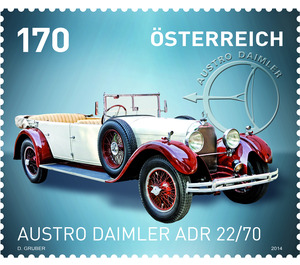automobile - Austria / II. Republic of Austria 2014 - 170 Euro Cent
Theme: Traffic, Transportation & Mobility
| Country | Austria / II. Republic of Austria |
| Issue Date | 2014 |
| Face Value | 170.00 |
| Edition Issued | 200,000 |
| Printing Type | offset |
| Stamp Type | Commemorative |
| Item Type | Stamp |
| Chronological Issue Number | 2453 |
| Chronological Chapter | OOS-OE2 |
| SID | 483965 |
| In 70 Wishlists | |
With the Austro Daimler ADR 22/70, probably the most successful sports car of the pre-war period, the popular series "Cars" in this special stamp is a worthy sequel. The 1899 founded "Austrian Daimler Motors Company Bierenz Fischer u. Co "was originally a subsidiary of the German Daimler-Motoren-Gesellschaft, which produced passenger and heavy vehicles, buses, rail vehicles and marine engines from 1900 on. In 1906, Ferdinand Porsche began working for Austro Daimler, and under his leadership, Flugmotore and Rennwagen.1909 / 10 Austro-Daimer, as the company was commonly called, separated from the German mother and traded until 1928 as "Oesterreichische Daimler-Motoren-Aktiengesellschaft". During the First World War Austro-Daimler was one of the Škoda factories and was one of the largest armaments producers in the vehicle sector of the monarchy. After the war, Austro-Daimler struggled with economic problems and therefore entered into a "community of interest" with the Puch plants in Graz. Then Porsche left the company in 1923 and moved to the German Daimler plants in Stuttgart. Karl Rabe, head of the passenger car construction department, then took over overall technical management. Under his leadership the successor of the successful type ADM (1923 to 1928) was the ADR shown here. The ADR was like its predecessors a model of the upper class and distinguished by its interesting frame construction - instead of the platform frame of its predecessor, the ADR used a central tube frame, which was also responsible for the "R" (for tubular frame) in the name. The light-alloy engine with three-liter displacement and valve train by means of a vertical shaft had been taken over virtually unchanged by "ADM 3 liters" - the power, however, was initially throttled to 70 hp, resulting in the type designation 22/70 - 22 control horsepower and an actual output of 70 PS - revealed. The top speed of the ADR was - depending on the body - stated at around 105 km / h. The power transmission took place via a four-speed gearbox on the rear wheels. The ADR was highly successful - it was exported all over the world - in total edged from 22/70 hp to 1931 around 2,600 copies with a variety of superstructures. One of his very sporty successors was the ADR 6 "Bergmeister" - the name refers to the success of Hans Stuck, who was able to win the European Mountain Racing Championship with special racing versions of the ADR in 1930. In 1934, Austro-Daimler, Puch and the Steyr-Werke merged to form the "Steyr-Daimler-Puch AG", and car production in Wiener Neustadt was discontinued. The vehicle pictured on the stamp can be admired in the Oldtimer Museum Koller am Heldenberg in Lower Austria.


